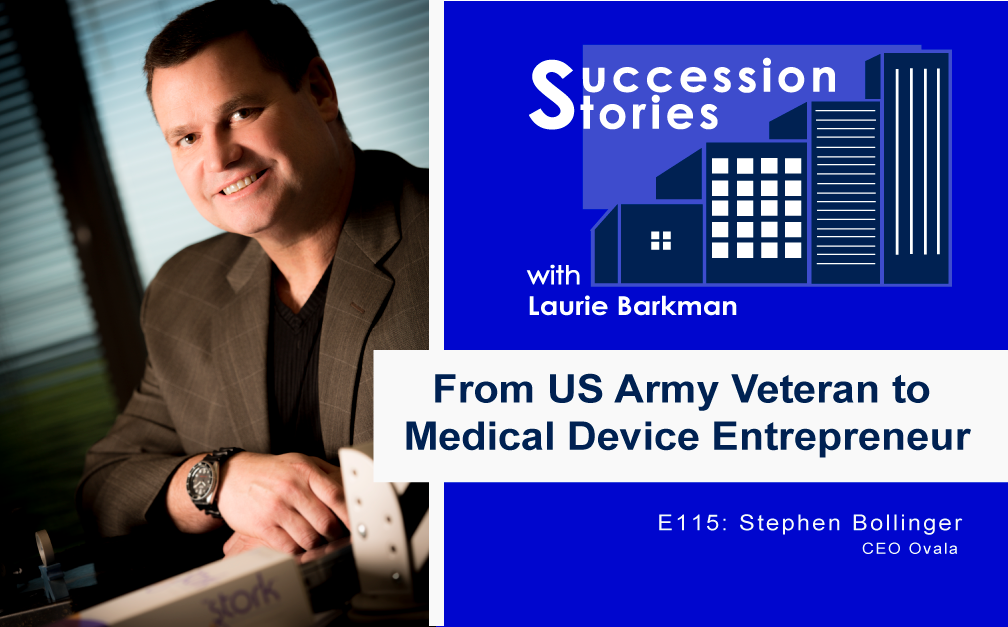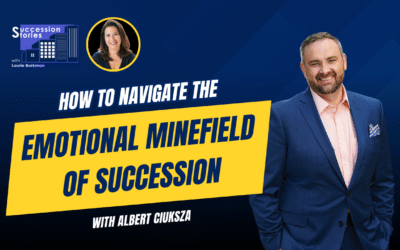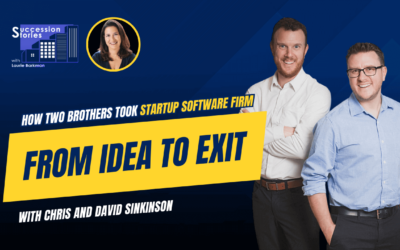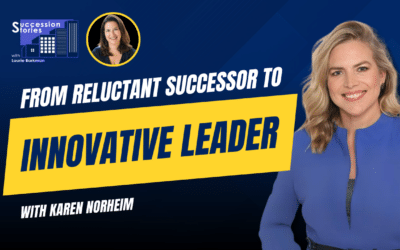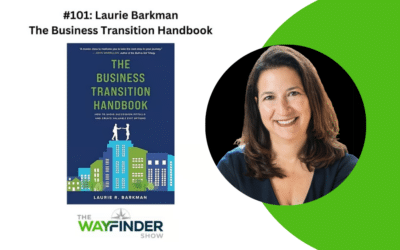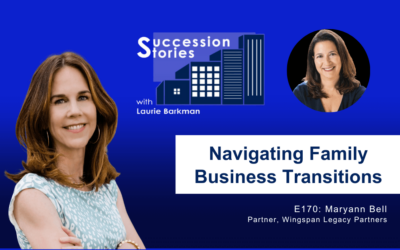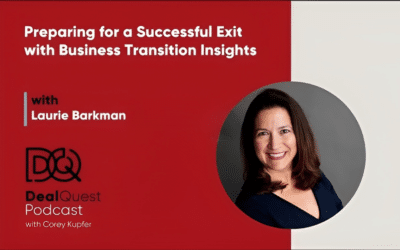US Army Veteran Stephen Bollinger is a serial entrepreneur in the medical device industry. Stephen’s superpower is discovering market opportunities to help people live better lives. During his career, he sold three medical device companies. He found a market niche by increasing the availability of medically proven approaches. Enjoy this “What’s Next” Succession Stories episode about finding a passion that makes an impact with vetrepreneur Stephen Bollinger.
Listen in to learn more about:
- Achieving success through connection with customers
- Deriving opportunity from challenges
- Finding your niche
- Developing viable products that address consumer needs
Show links:
https://www.linkedin.com/in/lauriebarkman/
Learn more about business transition planning at https://thebusinesstransitionsherpa.com
Visit www.meetlauriebarkman.com to request a business exit readiness assessment
Subscribe to the Succession Stories YouTube Channel
About Succession Stories Podcast
Succession Stories, hosted by Laurie Barkman, is an award-winning podcast guiding entrepreneurs from transition to transaction. From building value to letting go.
If you are an entrepreneur looking for inspiration to create a more valuable business, or an owner who wants to figure out the best way to transition or sell their closely held company, this podcast is for you.
Join our community of owners! Subscribe to the Business Transition newsletter at https://thebusinesstransitionsherpa.com
Get a copy of Laurie’s book, “The Business Transition Handbook: How to Avoid Transition Pitfalls and Create Valuable Exit Options”
www.theBusinessTransitionHandbook.com
SPONSOR: STONY HILL ADVISORS
Stony Hill Advisors works with owners like you to get ready and maximize value when you’re ready to sell.
Visit www.stonyhilladvisors.com/podcast for a complimentary business valuation.
Transcript
Intro:
US Army Veteran Stephen Bollinger is a serial entrepreneur in the medical device industry. Stephen’s superpower is discovering market opportunities to help people live better lives. During his career, he sold three medical device companies. Stephen’s story unfolds with his transitions from the military, to sales rainmaker, to medical product innovator. He found a market niche by increasing the availability of medically proven approaches from doctor care to over-the-counter. His mission is to address critical and common women’s health issues that can also lead to depression. Enjoy this “What’s Next” Succession Stories episode about finding a passion that makes an impact with vetrepreneur Stephen Bollinger.
Laurie Barkman:
Steve Bollinger, welcome to Succession Stories. I’m excited to speak with you. You’re a serial entrepreneur, you’ve got an incredible background, your journey from the military to following your passion and entrepreneurial ventures is an exciting one. Welcome.
Stephen Bollinger:
Thank you.
Laurie Barkman:
We met because of the Tepper School of Business, and you’re a fellow adjunct professor, so we’ll also want to talk about that. Why don’t we start with you? Tell me your story.
Stephen Bollinger:
Boy, well, it’s a long and twisted story but it began with the United States Military Academy. I was looking for an engineering opportunity and my father introduced me, he was from the Navy, he introduced me to the United States Military Academy and the United States Naval Academy and he asked me, “Do you want to live your life on sea? Or do you want to live it on land?” I said, “I prefer land, dad,” he goes, “Well, I think you should think about West Point,” so I began my path there, had a great experience at the Academy, and from there, we graduate as second lieutenants and join the military, I became an artillery officer, I was blessed to be an Airborne Ranger, I was able to do some great things in the military. I spent my five years in, which is a requirement to be a West Point graduate but after my last Gulf War, my wife, who was a news anchor at the time, said, “Either you’re gonna marry me or Uncle Sam,” and 32 years later, I made the right decision, I’m still married to my lovely bride.
At that point, I needed to figure out what I wanted to do next and my father, I went back to him once again, he said, “Son,” I said, “Dad, I haven’t practiced engineering, I don’t really know what a civilian does,” he goes, “Well, sales, my son get into sales, you know, where the rubber meets the road.” I’m like, “Okay, dad.” There was a recruiting group that specialized in Academy graduates that were getting out of the military and at that point, I decided that I wanted to get into medicine. I’ve always had a passion for medicine, but I wasn’t in the top of the class at West Point and only the top 1% can actually go into medicine from there so I always, I was always interested.
At that point, I joined a company called Deknatel, which was a really interesting company, a mature company dealing with the cardiovascular space and I began there in advance to, I’d be going, I became the youngest sales trainer and then my national sales manager left to join a new startup and I just didn’t know what to do next. I was kind of like, but my territory was very mature. I was in the top five sales reps and I just didn’t know what I wanted to do next. At that point, he asked me to join him, which was a company, a small company that was into the laparoscopy field, and they specialized in general surgery and OB GYN, and it was a really interesting company called American Hydrosurgical. Well, and I joined that company, I was one of the youngest sales reps at the time. We had about 10 sales reps, we were penetrating a new market, and I was blessed that I really understood my region. I lived in California at the time and I was a top sales rep for a couple years and then I started making actually too much money, which is kind of weird, right? The national sales manager said I was sandbagging my numbers, because I was doing much better than projected and at that point, I made a realization that I noticed a lot of sales reps in the medical industry as they aged, they just became a little bit rough, a little bitter, a little. I just didn’t want to be that person. so I was asked to move in house and I started working on project development, marketing, new products, and a regulatory path as you know.
As a small company, I was able to learn a lot about what happens inside of a company and at that point, I started on developing new products for them and new technologies and my engineering background started to become useful and what I decided then was, our president at the time decided that he wanted to sell the company so I worked on the diligence team to help the acquisition happen and that was my first taste of, “Hey, you can really make a lot of money and be successful in this industry.” He sold the company, I was asked to take the next steps with him and they wanted me to join bar Dave Hall in New England and I said, “Absolutely not. I have no interest in moving from Florida to the Boston, Massachusetts area,” so I was found by recruiting group that had a company that was interested in an eclectic person like myself, I really was a jack of all trades, but master of none, if you at that foundation, and a company’s name was Mentor, it was out of Santa Barbara, California, so wouldn’t you know, I moved from San Diego, I moved to Florida and now I uproot my family and we moved to Santa Barbara, California and it was a wonderful opportunity.
They had a technology that was not working, they had three engineers that were trying to solve a problem in body contouring fat removal. Mentor Corporation was the market leader in breast implants for women’s health, primarily focused on reconstructive surgery for women that have had cancer. It was a wonderful company, they also had a neurologic division and they had an atomic division. The atomic division was out of Massachusetts, the Euro logic division was out of Illinois, so when we looked at those two opportunities, they asked me to come on board and run a project that would work with all three divisions of this company.
At this point, I’m just trying to figure out where the bathrooms are and we took a non functioning device in 18 months, we took it to a functional, completely new system. We launched the product internationally and worldwide and today, it’s still the number one product used for lipoplasty and that was done around 1997-98 timeframe so at this point, I loved my job. I was doing international travel, but I was traveling about 90% of the time and I had a new young son, and I’m like, “This is crazy. I didn’t get out of the military to be living away from my family again,” so the other thing that was interesting was Mentor no longer was giving stock options to directors and below so I was really not building wealth, like I wanted to and I went to a meeting in San Paulo, Brazil and this meeting was very interesting. I get to the airport and I’m like, “I’m an American, I don’t speak Portuguese.”
I’m walking through the airport all buttoned up in a suit ready to go and I see this wild man in a Hawaiian shirt smoking a cigarette has a scrunchie beard, you know, very Greek oriented. He’s cussing at the customs in English. He’s going crazy and I’m like, “Oh, my God, this is a terrible representative of the United States,” and I thought, “I just gotta get out of the airport and go to my meeting so I go to my meeting.” It’s a medical meeting and the following morning, I get there and what do you know?
That crazy Greek guy that I just met at the airport was in the booth next to me. He was the CEO of his company, a founder of his company called Byron Medical, very interesting guy. We were like Yin and Yang, ice and fire. We came from totally different worlds, we thought of things differently and for about five days at the meeting, he kept wanting to meet with me and have lunch and dinners and strategies and I had no one else to talk to so I went to him and we had an interesting time. At that point he came and said, “Hey, I’d like you to come join my company.” I’m like, “Absolutely.” But I said, “There’s no way you and I can live together at all,” so he kept pursuing it. He sent me tickets out of Santa Barbara to go to Tucson, Arizona. He brought my wife, my son, who is now a baby at the time. We flew out to Arizona. He picks me up in his car. He’s smoking a cigarette out the window talking to us in the back and in Arizona if you’re not familiar with Tucson, they have no streetlights and he just moved into a new house. It’s like 10 o’clock at night, and he can’t get home. I’m like, my wife was like, “Oh, just just how long is this weekend supposed to last?” So I met with him the next morning. I met with his wife, I met with his family and met with the business and I really thought I could make a difference. My wife and I went back and said, “Hey, you want to do this?” I’m like, “Absolutely,” and we joined the company.
When I got there, I had experience with regulation and I had experience with product development, marketing and sales. These guys were purely sales people that were outsourcing products. Well, wouldn’t you know the day I get there, they’re having a product recall, I have to do a product recall because products are breaking in the field so I went through the regulatory system, they had no 510 K’s they were breaking every law known to me, and they were distributor making medical devices. I said, “Listen, we need to stop,” so I wrote actually 23 510 K’s when it was easy to write a 510 K. I wrote them to the FDA. I submitted them and then I talked to the FDA. Actually, the division head was Celia Witten at the time and I said, “Listen, Dr. Witt,” and I said, “We have a chance here to make an impact. The lipo plasti field is considered a class three medical device and that means it requires extensive studying. Nobody wants to study the space. Every doctor is using this technology today and every company is selling it off label. If I do a clean submission to you, would you give me a class two authorization to market and down classified it from three to two?”And she said yes, so I sent that information. We down-classified it as the class three and class two, we’re now allowed to say that removal or lipoplasty. Again, this is about two years into it. I had to fire his wife, his children. We had to find all new vendors and manufacturers so I was busy 24/7 enjoying life and then I called my old boss at Mentor Corporation. I said, “Hey, you know, we cleaned up this company. My CEO, my founder, wants to retire. He’s about 67 at the time. What do you think about this company?”
He came in, and within six months, he acquired our company for about 14 times sales so it was a wonderful opportunity. Everyone did very well but the next thing that was very interesting was the fact that they wanted me to move from Tucson, Arizona, back to Santa Barbara and I was just like, “Now, I don’t think I can do that again.” So I didn’t join Mentor. I didn’t regain with them. I stepped back and tried to figure out what I wanted to do next.
One of my manufacturers that I recently hired to build a product was out of Boston, Massachusetts and he said, “Steve, I have this idea in minimally invasive surgery for interventional radiology and cardiology to close the femoral artery once the physician accesses it.” I’m like, “Okay, yeah, tell me about it.” I told him about it. I met a doctor that was one of the well known Harvard grads, interventional radiologists and or interventional cardiologists. I said, “Okay, yeah, I can do this,” so we started a company called Angiolink. We started in 2000. We did 26 trips to South America doing medical research. In four years, we raised around 26 million, and we sold it for $180 million dollars so it was a really great opportunity. Really, my first taste of success and of course, now, we sold this company to Medtronic Corporation, and they lived north of Boston, I lived in South Boston, and I’m like, “Oh, there’s really no way am I going to do that commute. Just absolutely no way,” so I stayed on board for a year. They had this package for me to help the transition. At that point, I got a real estate license, I built a suit of armor out of 304 stainless steel, I learned how to weld and my wife and I started fencing and my wife came up to me and said, “You need to find another way of occupying your time you know, you’re going crazy,” so I said “Okay.”
Laurie Barkman:
You’re not kidding, you literally made a suit of armor?
Stephen Bollinger:
Yes, and started fencing. In my basement, I have anvils. I have all these forming materials. I got hammers. Yeah. It was very exciting though, after I did that, my wife really guided me to go figure out what I want to do next. One thing that was very interesting was this venture capitalist out of Boston came up to me and said, “Hey, you have a very interesting background, would you like to look at a biologic company?” I’m like, “I don’t know anything about biologics.” Now, you got to understand, from the military, we’re taught that there’s a new job, you can’t learn in two weeks. That was kind of the mantra so I said, “Listen, I don’t know anything about biologics. I don’t know anything about chemistry.” He said, “Listen, we need someone that is device-oriented, that takes this product forward, because all the scientists in the other region just can’t really put the package all together.” I said, “Okay, well, I’ll give it a try,” so I joined the company Pervasive Therapeutics, a very interesting company, Harvard-based technology dealing with allogeneic, endothelial cells. It was fantastic. We raised around $20 million. We did our first clinical study, it was very successful. In 2008, the market started blowing up for medical devices, the industry was changing in 2008 so we worked out an opportunity and sold the company to Shire. At that point, it wasn’t a great success. It was really bio dollars, as we said, but it was a way to continue the success of the company with a partner that could actually grow it.
Laurie Barkman:
Let me ask you a question about the two experiences you had in selling. You sold two strategics? Were they partners already of your companies or did you approach them? Were they aware, why did they acquire you?
Stephen Bollinger:
I don’t know. Honestly, we were very good at telling a story. Penetrating a marketplace, especially in the Angiolink with respect to interventional radiology, and cardiology and we started in our clinical studies in our work, we started meeting the key competitors in the space and in that process, we as executives are out in the clinical study arena, in the US study, and we’re meeting senior management as we go and we just started telling our story to them and it took about two, three years from the initial conversations to an acquisition so it took a long time, but we built relationships. We kept them constantly informed of what we’re doing. We never let them not think about us and I think that was the secret to that acquisition.
Laurie Barkman:
Did you work with an intermediary or did who ended up being the person that was quarterbacking the M&A process from the team?
Stephen Bollinger:
Once we got the partner – it’s very difficult to be founders and executives of the company and be in the negotiators – so we hired an investment banking group out of Boston to support us to do that additional legwork to try to create an auction environment. It was actually very rocky. We had, so this is actually the timeframe of 911, okay, and we had an offer from Medtronic at the time. That was really sweet. I mean, like beyond perfect. We signed letters of intent. We were going to Washington DC that morning. We’re going to Washington DC for an Interventional Cardiology meeting called TCT so we were flying to this meeting, to close the deal, sign the paperwork, everything would be done. We are just on cloud nine, the whole company is bouncing off the walls. Now, my partner and I are totally opposite, again, of Angiolink. I like to be 30 minutes early. He likes to be two minutes late and I hate traveling with him. I mean, we just hated traveling with each other because I’d be on the plane going, “Oh my God, he’s not gonna make it,” and you know, before the doors would close, he would step in and be there. I mean, he was the luckiest person. When it came to that kind of stuff. He was always late. He was always this way. wonderful gentleman, really smart guy but in that process, we said, “Alright,” I said, “We’re gonna fly together again.” I’m like,” Alright, if we’re gonna fly together, we’re flying first flight out. I’m picking you up. We’re going to leave the office together is what we’re going to do,” so eight o’clock in the morning, our flight was supposed to leave around 10. I usually leave at six but we left a little later and once 911 hit we weren’t on the planes, but we were supposed to fly that day. When that all happened, that deal fell apart. Everyone went radio silent for 12 months, the people we negotiated with at Medtronic left or were let go, the change of the business development people were all gone and we had to start all over again, another six to 12 months to regain the confidence to get the deal done and we it was not as sweet as the deal we had initially so it was definitely a rocky road.
Laurie Barkman:
Wow. Sorry to hear that. That’s a crazy story. I have heard about deals falling apart, though that one probably is obviously something we cannot control. A lot of times deals fall apart because of diligence or other reasons, right? Or price. You had it all negotiated and then there was just a global tragedy.
Stephen Bollinger:
We were doing that happy dance. We were so excited. We were just…at this point I’m totally fried, I’ve been doing 24/7 medical devices, biologics, working around the clock, had our second child, and we’re just like, “This is crazy. I’m really burning the candle at both ends,” so I took a breath. One of my investors was Bob Higgins out of Highland Capital Partners, a brilliant, brilliant gentleman and I said, “Listen, I need a break.” He said, “Come be an executive in residence at Highland Capital Partners,” so I’m like, “Fantastic.” What an executive residence does is, we are basically a filter for new technologies and ideas so we’re seeing 10-15 deals a day and it’s just, it’s huge. It’s a very, very fast paced program, and it was just crazy, but what it did allow me to do was see other ideas in the medical device field and see, “Is this something I’d like to do next?” And I had this idea and I really thought about the space and I stepped back and said, “Listen, the success I’ve had with selling companies in the medical device industry is no longer the same bottle, we can’t achieve the same success doing the same old model,” so I wanted to do something different. What I wanted to do was, I studied, actual medicine, and I took a whole portfolio overview and said, “Alright, how has medicine evolved?”
This started with infectious diseases, we solved that problem, we started living a little longer than the next thing we started to have as cardiovascular disease states are living longer but now we have ways of solving that so medicine did a great way of solving cardiovascular. Now everyone’s living longer, as well as diabetes. We’re living longer, but are we living better? I looked at the aging disease state and I said, “Wow, this is a really great opportunity, I think, it’ll re-energize my energies and my focus.” Well, one of the things that was a challenge was being a gulf war veteran, my wife and I wanted to have children when we got out, and she had three miscarriages in a row, could have been us could have been a major thing. Everyone was blaming it on the military and I’m like, “I don’t know.” She kept on seeing the same doctor, she got pregnant again, I’m like, “You’re done. We’re not going back to your OB GYN.” Now, at this point, I’m in San Diego, I was working with very high end OB GYN fertility specialists with our product and I knew this guy very well and I said, “You’re going to go see my doctor, Dr. Haggerty,” we went to go see him and he said, “Steve, you can’t come in. I just got to talk to your wife,” so I was sitting in a waiting room and all these couples were just stressed out over the gap between natural intercourse, and the more aggressive treatments like IUI and IVF and I said, “Wow, there must be a way to bridge this gap.” That was back in the early 90s. It took me 10 years to say, “Is this idea really worth taking the next step with? “ What I did was I looked at this and I said, “I really want to do something different. I want to take medically proven approaches that were once only available under a physician’s care, through innovation, take it directly to the end user.” That was taking a prescriptive device over the counter through innovation and fertility became a real passion of mine.
What we did was we created a company called Renewable Women’s Health. The product was called The Stork and we basically bridge that gap with a condom like collection and a tampon like delivery system to aid couples on their path to conception. We loved it. We did a US launch, we did a worldwide launch. We sold in Canada, China, we sold in the UK, we sold in Europe, and Australia and it was always a struggle to get new customers but the product was super successful. People that weren’t getting pregnant, through even IUI, IVF, or natural intercourse used our product, and we’re having great success. The challenge was finding new customers is the cost of marketing to find a new customer. So now it’s about 2019. And one of my distributors out of China says, Steve, I want to buy your company. And at this point, the company was doing okay, but we weren’t hitting the trajectory that we always wanted to because we just didn’t have enough marketing dollars to support an over the counter product.
Laurie Barkman:
Were you bootstrapped at this point? Did you fund out of your own pocket?
Stephen Bollinger:
I had another investor as well that followed on, a high wealth family that supported us so I’m putting my money in, he’s putting his money in. In 2019, we have finally agreed to sell the company to that group. Now it’s like, “Okay, what are we going to do next?” One of the things that was so exciting to me were all these older ladies that were getting pregnant and older couples that were having a problem conceiving, conceiving with the stork. They’d call me up and say, “Steve, I’m really upset at you.” I’m like, “Oh, my God, what did I do wrong?” She goes, “Well, you got me pregnant. Thank you. You helped us on our path of child but that child was like a football coming out of my vaginal track. And you know what? Guess what? Now every time I cough, sneeze or dance, I tickle in my pants. Can you solve that problem for us?” I’m like, “Okay, well, let me look at it,” so you’re now becoming an expert on women’s…Oh, now, Women’s Health became an extreme passion and the reason why I love women’s health and I say this, you know, very jovially is that men go through two phases of life, puberty, and midlife crisis, right? Women go through about seven unique physiological changes of life so there’s so many opportunities to help women that really aren’t getting that help and with technology advancing so much in the 80s, and 90s, and 2000s, a lot of things that were functional, basically, we’re getting to advanced procedures that were being utilized, because physicians evolved forward but the challenge is, many of those ideas are very positive and can help women if we can make them consumer friendly, right.
Women are stereotypically a much smarter consumer of healthcare. Example, men, stereotypically, we get coughs and colds and booboos and, you know, cuts and bruises and we don’t really see a doctor until 35 and we have a prostate exam to look at a diagnostic opportunity for prostate cancer. Whereas women at age 13 to 16, they’re learning their body, by the time they’re 20, 21 they really say, “Doctor, no, that doesn’t work, that antibiotic’s no good, here’s what I want.” They really understand their bodies and their evolution. So they’re just a lot stronger consumer of health care so when I looked at those two models, I said, “Wow, women really, this is a really great opportunity to help women on their path,” and me being married for 32 years, my wife has gone through almost every one of the phases, so I’ve been blessed to have a Petri dish in my own household so I brought this idea to my wife and said, “Okay, what do you think about this?”
What I loved about our technology Ovala, and now Ovala Inc, the product’s name is Revive, is that when I first thought about it I said, “Well, what is the disease state? Like what is it all about?” And it’s a physiological issue, that connective tissue that supports the urethra no longer have the elasticity so every time you have resident movement, it causes leaky, it’s right, you know, so that’s the physiological, it could be smoking, could be exercise, it could be childbirth, there’s multiple factors to drive the physiological issue but what really intrigued me was the psychological impact that’s both physiological and psychological. The women that have stress incontinence leak, and what that happens is they become very subconscious. They stop going out and they stop interacting. They just become more introverted and so they change their lifestyle, they slowly gain weight, they just get really unhappy that their relationship with their significant other is disturbed because of this whole event so I said, “Wow, this is a physiological and psychological moment.” I love it so they said, “How big is this marketplace?” And I said, “Okay, well, let’s figure that out.” When you looked at the market size, you got really excited because not in a negative way, I guess one out of three women worldwide, have some form of stress in climates, right, have some form of incontinence so there’s urge incontinence or stress incontinence, but they have this disease, they diagnosed every year 18 million in the United States. I said, “Wow, that’s just a huge number.” Then I found out that 80% of these women are diagnosed with guess what? Depression. I said, “Wow, this is really something that means if we can solve this problem, we can have impact.”
Once I figured out that there was a good market, an interesting opportunity, a strong need, the next thing I looked at is, well, “What is the trend in the marketplace?” This is where I kind of just said, “Alright, what are women using today?” Well, the majority of women use pads, and the challenge with pads is they’re brilliant for the menstrual cycle but for incontinence, most women are dehydrated, because they don’t have your honor system so the yarn is usually acidic and pungent so it causes both discomfort, and odor so what a terrible solution. In fact, experiencing this with with acquaintances and friends and family, what we find out is many women are pad smugglers, they go to an event, they go to a pad, they laugh, they have fun, they leak, they go to the bathroom, they don’t want to flush the pad because it could include the toilet so they don’t want to put in the trash to seem like they have a problem so they carry a ziplock and carry it out. I’m like, “Oh, my God, this is terrible.” So I said, “Alright, not a good solution,” and then when I looked at the standard of care by physicians, there are things called pessaries and pessaries look like everything from a Dunkin Donut to a Rubik’s Cube, so I’m like, “Oh, my God, these are crazy, “ that I looked at physical therapy but problem with a pessary is compliance. Women basically have to give up, intercourse, if they have a pessary. Well, men are now hopped up on Viagra. There’s this disconnect so pessaries, really, were not a good option for most women. Bottom line is, surgical opportunities were much more difficult so I did figure it out to say, this is the one thing I wanted to do. We developed the company, we launched in the United States, we now sell online, we sell on Amazon, and hopefully going into retail so that’s kind of where I’m at today, and just try to do the best I can.
Laurie Barkman:
Well, that’s amazing. I mean, I think this is a really great illustration of someone, you’re someone who always is sort of going to what’s next. You started out in the military, you developed a passion and a career in sales and found an entrepreneurial path in medical devices, you had some exits, you helped others with an exit and you’ve continued to learn from all of these experiences to help people with real problems. Conceiving a child, you’re right, and it can cause a lot of emotional stress for families, financial stress for families, and then incontinence for women. It’s interesting that you learned about not only the prevalence of it, but also these emotional and social impacts that this problem can have for people. Ultimately, as you know, a medical device entrepreneur, that’s what you’re trying to do is you’re trying to, you’re creating a social good, but at the same time, you’re an entrepreneur, and you’re trying to create value in the business so I find your story very interesting and compelling. It’s very different from other entrepreneurs I’ve had on the show because you’re creating a product, right? We can all sort of relate that there’s a widget here, but it needs FDA approval. There’s a risk associated with these products. You can see people being fearful of lawsuits or what have you but you’ve persevered and you’ve created products that have been successful.
I guess just to kind of wind down and have you think about your entrepreneurial experience and context of what do you think would be three things you would say to an entrepreneur who’s listening, and maybe they’re not in the medical space so they can’t relate to you from that perspective, but they’re creating a product or they’re creating these relationships with of industry. You know, Medtronic is a huge industry player you sold to strategics. That’s not an easy thing to do. No matter No, excuse me, the Medtronic was a deal that didn’t go through but nonetheless, you got their attention so if someone’s creating a company, if they’ve got a successful business that they want to get the attention, after they’ve built the product market fit and gotten to the point where they think they can position it to sell, what would be some of your M&A lessons learned that we could kind of put a bow on here?
Stephen Bollinger:
Ah, so relationships are everything and I think the one thing I learned, I’m still learning is, so much of this deals with the one on one connection, listening to what the customers are looking for and I find that that really is critical and not being hubris. Not drinking your Kool Aid, that you actually believe everything that is real, but selling a real story, selling them an opportunity, not over promising and under delivering, but over delivering and under promising, I think is critical. I always tell people, the three things I think about for an entrepreneur is that one is, do what you love, you have to love what you do, because it’s going to be so stressful, there’s going to be ups and downs, and it’s a mess. But if you love what you’re doing, and you have an internal mission of why you’re doing it, and you always have that as a mantra, it keeps you grounded. The next critical thing is never give up and many, many people get into a lot of good companies that fail, because the team just hits so many barriers, they just throw up their hands, they can’t find another way, and they just walk away and I find that that that is so critical is just to never quit. Always look at things as every challenge is an opportunity. I always laugh when people say, “Oh, we have a huge problem here.” I said, “Oh, it looks like we have an opportunity.” I think that mantra really helps get through the hard times because easy times are easy. They’re not there. Every company that sold, there are, in my opinion, struggles that you never see, the chaos behind the curtain. The challenge is everybody tells us the success story. They think, “Oh, you got lucky. Right? Oh, you got lucky.” You didn’t see all the tears that were there cried during the development of a product.
Laurie Barkman:
Absolutely. Well, I think that’s a great mantra, every challenge is an opportunity and it’s certainly something that ‘s been consistent across your experience. Steve, if people want to get in touch with you to learn more, how can they find you?
Stephen Bollinger:
You can reach me at sbolinger@userevive.com. You can reach out to our website and there are numbers that you could get a hold of me at and we’d love the opportunity if people would like to talk to me; door’s wide open.
Laurie Barkman:
Okay, awesome. Well, thank you so much for coming on to the show today sharing your experience sharing some of the trials and tribulations along the way and some things that you’ve learned, so really appreciate you.
Stephen Bollinger:
One thing that I’d like to leave with is, in the military, it’s arrangers, we had one thing going on, if things are going to well, it’s an ambush so just be ready that when everything is going perfect, you need to be thinking of why it’s not going perfect to solve those future problems.
Laurie Barkman:
That’s a good one to leave. Thank you so much, Steve.
Laurie Barkman:
Listeners, thank you so much for your support. Catch Succession Stories on your favorite podcast player or YouTube to subscribe to the show! If you want to maximize the value of your business and plan for future transition, reach out to me for a complimentary assessment at meetlauriebarkman.com. Join me next time for more insights from transition to transaction. Until then…here’s to your success.

